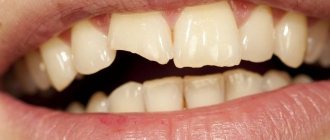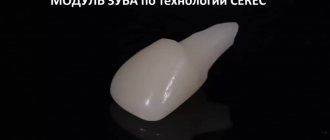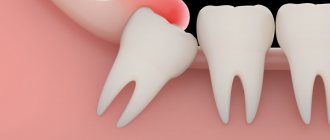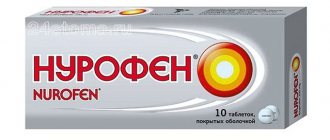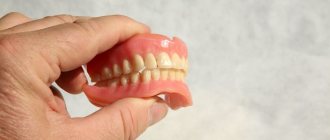Orthodontic treatment is a difficult period: often one or another seemingly small problem seriously overshadows life. Unfortunately, doctors cannot always foresee all the questions that arise, or there is not enough time at the appointment to talk in detail about all the intricacies. This article will help fill in those gaps and make your life with braces easier and clearer. Also, read the answers to the most frequently asked questions.
- Are your braces rubbing?
- What to do if a brace comes off?
- Teeth hurt after getting braces
- The archwire flew out of the bracket, what should I do?
- Broken bracket or archwire?
- Treatment of damage to the oral mucosa
- What can and cannot be eaten with braces?
- Menu during orthodontic treatment
- How to brush teeth with braces?
Are your braces rubbing? Orthodontic wax will help.
If any element of the braces system rubs on you, seal it with orthodontic wax . Usually it is given by the orthodontist after fixing the braces. In addition, you can use regular dental wax in red strips; it is not so flexible, so it must be preheated in hot water. From wax of any type, after heating it, you need to make a ball the size of a match head to a pea and attach it to the dried surface of a bracket, hook or other element of the bracket system.
Method of applying wax to brackets.
What to do if your braces come off?
Contact your orthodontist immediately and let him know. The bracket should be fixed for 1-3 days . Since the tooth, not attached to the arch, begins to return to its original position, which leads to the need to switch to previous arches: months of treatment are wasted. Moreover, this process is most critical in the middle and at the end of treatment, since during these periods thick and hard arches are used and even a slight displacement of the tooth can make it impossible to install the arch into the bracket groove. It should be noted that only those teeth that actively moved during orthodontic treatment have such a tendency, so it is important to inform the orthodontist from which tooth the bracket came off.
When removing the bracket, be careful not to swallow it! This does not pose a serious threat to health, but there is a small chance of injury to the mucous membranes of the gastrointestinal tract. The main problem is different: you will have to pay the cost of a new brace and, possibly, wait for the clinic to purchase it (the clinic does not always have a stock of all braces in its warehouse), which can increase the duration of your treatment. Most often, if the bracket comes off, it remains securely fixed on the arch, but at the same time is movable (see photo above). In this case, you do not need to do anything before visiting the orthodontist. But, if the braces come off from the last teeth, then they almost immediately fly off the arch and, in this case, it is important to notice the unsticking in time (often it happens while eating) and remove the bracket from the mouth, pack it and take it with you to the appointment to the orthodontist.
How to install correctly
Most often, the patient does not install the arch himself. This is done by an orthodontist who has sufficient skills to fix the arch .
To begin with, he adjusts the size of the arch to the size of the jaw, since it is much longer than our oral cavity. The unnecessary part is cut off with scissors, and the arch is completely placed in the dentition.
Then, using rubber rings, the arch is inserted into the sinuses of the braces of the last and penultimate molars (large root teeth in the depths of the cavity that perform a chewing function. There can be 3 of them on each side: the first, second and third) and secured with round rubber bands (ligatures).
They hold the archwire tightly and prevent it from jumping out of the bracket. Sometimes, after fastening, the doctor can move the arch in different directions in order to best fix it and not injure the inner palate.
Teeth hurt after installing braces: what to do?
- Teeth may hurt for 3-6 days after installing braces and after switching to rigid rectangular arches (usually several days). The intensity of pain varies from person to person, so it’s up to you to take painkillers or not. If the pain is difficult to bear, then take painkillers that help you with headaches. To begin with, you can try: aspirin, citramon-p, nurofen, pentalgin, askafen and analogues. If their effect is not enough, then take more serious non-steroidal anti-inflammatory drugs: nimesil or nise. Do not forget that these drugs reduce the intensity of inflammatory processes, which means they stop the movement of teeth.
- Avoid using ketorol and ketanov as they are very toxic and their prolonged use is a serious risk.
Diagram of tooth movement in bone.
- Use a local anesthetic. There are a number of over-the-counter medications that can help relieve toothache while wearing braces. They have anesthetic properties (they dull the pain for several hours). Available in the form of mouthwashes and gels. For example, "Orajel" or "Colgate Orabase". Sometimes it is possible to be allergic to such drugs, so before use, always review the instructions for the drug; they also indicate the correct method of application.
- Be careful when brushing your teeth! If you are used to pressing hard on your toothbrush when brushing your teeth, you may experience pain. Try to brush your teeth with light and slow circular movements, take your time and open your mouth a little wider than usual. Only use brushes with soft or medium-hard bristles.
- Eat cold food, drink cold water, keep ice cubes in your mouth. Cold reduces the sensitivity of pain receptors. In addition, many of the modern orthodontic wires used at the beginning of treatment are thermoactive. This means that the lower the temperature in the oral cavity, the less force the arc develops (the changes are completely reversible), which means the teeth hurt less. But, you should not abuse this trick: when the arch is weakened, progress in correcting the bite will slow down proportionally.
- If you experience severe pain immediately after wire placement or replacement, tell your orthodontist! When replacing the arch and other manipulations, light to medium pressure is considered the norm; it also ensures maximum speed of tooth movement. Contrary to popular belief, very strong pressure on the teeth does not speed up, but slows down the treatment process and, in addition, causes serious discomfort to the patient.
Causes
Braces are considered a fragile structure, therefore, when using the product, the patient should follow certain rules and follow the recommendations of a specialist. This will maintain the integrity of the system throughout the entire treatment period.
The locks of the device are glued to a special adhesive. The adhesive has high strength values. It can withstand a certain pressure, but is destroyed when the force increases.
The power arc is deformed when the system is installed. She puts the main pressure on the locks, trying to return to their original state. With crowded teeth and some other malocclusions, uneven distribution of pressure occurs.
So, the fixation of the elements of an othodontic product can be impaired for several reasons. Among them:
- Consumption of inappropriate products. Doctors recommend excluding hard, tough and sticky foods from the diet.
- Inaccurate movements when performing hygienic procedures for caring for the oral cavity. You should use a toothbrush with soft bristles and use dental brushes carefully.
- Pathological arrangement of teeth. An acute lack of space creates significant pressure on the dentition. Conditions for element rejection arise even with the most minimal arc parameters.
The period of wearing braces ranges from one to three years. The duration of treatment depends on the age of the patient and the specific clinical case. The longer the correction, the higher the risk of structural failure.
The archwire flew out of the bracket, what should I do?
- Most often, thin wires used at the beginning of treatment fly out of the last braces. Experienced orthodontists know how to minimize such phenomena. In particular, the arch can be bent behind the last bracket; in addition, thin arches are often placed only up to the sixth teeth, since they often fly out of the tubes on the seventh teeth. If this trouble nevertheless happens to you, try in front of a mirror using tweezers or nail clippers (just don’t bite off the arch!) to tuck the arch into the tube on the last tooth: this manipulation is akin to threading a thread through the eye of a needle. If you can’t do it or you don’t want to acquire new skills, then contact your orthodontist, he will quickly fix the problem.
- The arch can also shift due to low friction in the system (primarily applies to self-ligating braces). In this case, the archwire protrudes from one side and slides out of the last bracket on the other side. This happens because the orthodontist either forgot to fix the stoppers on the arch, or they turned out to be ineffective for one reason or another. The problem is resolved in the same way as the first point.
- When closing gaps or correcting crowding of teeth, the length of the dentition decreases, but the length of the arch remains the same, respectively, an excess of the arch appears behind the last braces. If the tip of the arch is large enough and pricks your cheek, then visit your orthodontist (by prior arrangement, of course), he will remove the excess arch in a couple of minutes. If the tips of the arch are visible, but do not seriously bother you, then do not worry and come to the next scheduled appointment, because this is a sign of progress in correcting the bite.
Main element
It is the arches that perform the main function in straightening the teeth and correcting the bite.
Using their force, they pull the teeth to a position in which the arch takes on its original shape. Here Newton’s law comes into play, which states: “The actions of two material bodies on each other are equal in numerical magnitude and opposite in direction.” This means that the force of the arch is trying to move the teeth into one row.
And the teeth, in turn, resist the braces and try not to budge. But in this situation the arc wins. Thanks to its alloy, it eventually regains its original shape regardless of any deformation.
The arcs differ from each other in their diameter and cross-section. The thinner the section, the thinner the arc itself.
More often, treatment begins with thin arches, since the teeth are just beginning to get used to the braces system and traction. At the end of treatment, the thickest arches (square) are installed, which completely fill the space in the bracket.
According to the cross-sectional shape of the arc there are:
Round arches have the least force on the teeth. They are used at the beginning of treatment.
Rectangular ones with medium traction are used in the spaces between round and square arches. Well, square ones have the greatest resistance and are placed at the last stage of treatment.
Broken bracket or archwire?
As with any other case of breach of the integrity of the brace system, if a bracket or arch breaks between appointments, you should immediately contact your orthodontist and, if necessary, make an appointment for an unscheduled visit.
- Breakage of a brace is a rather unpleasant incident, fraught with additional expenses for purchasing a new one and, in the worst case, an increase in treatment time. Remember one simple rule: if a bracket breaks , in most cases it needs to be replaced ! Moreover, the orthodontist may not offer you to do this. This is justified only in the final stages of treatment, when the tooth on which the braces are placed and all neighboring teeth are already in an ideal position. In all other cases, be sure to replace it with a new one! Most often, plastic, cheap ceramic and sapphire braces break. High-quality ceramic braces, including ligature-free ones, break much less often (Read about choosing high-quality aesthetic braces in this article!) Metal braces in this regard are absolutely reliable and never break in the oral cavity. A new metal bracket may only be needed if there is deformation when the old bracket is removed during a routine rebonding.
- Breakage of an arch is a fairly infrequent phenomenon and almost always the arch breaks during an appointment as a result of certain manipulations by the orthodontist. If your arch is broken, tell the orthodontist and come for an appointment: they will replace the arch with a new one.
A few words about prices
How much do Damon braces cost? The exact answer to this question will depend on a number of factors, including the choice of a specific system model and the pricing policy of the dental clinic. Installing metal braces on one jaw will cost approximately 35 thousand rubles. Fixing an aesthetic design will cost from 45 thousand rubles per row. Ormco products are quite expensive, but, on the other hand, they are distinguished by their impeccable quality, efficiency, comfort during treatment and many other significant advantages.
Treatment of damage to the oral mucosa.
During orthodontic treatment, the lips and mucous membranes of the cheeks and gums inevitably suffer. Sores are formed due to friction between braces, especially their hooks, and soft tissue in the mouth. This problem is especially acute at the beginning of treatment.
- Solcoseryl dental gel (sold in pharmacies) - it noticeably speeds up the healing of mucous membranes, and you can also lubricate the corners of your lips with it, especially after taking it. In addition, lips can be lubricated with Solcoseryl ointment.
- Rinse your mouth with salt water.
Salt water reduces pain and speeds up healing of wounds. Mix a tablespoon of regular table salt in a glass of warm water. Place the resulting solution in your mouth and hold for about a minute. Repeat this procedure several times a day, especially in the first days after fixation and at times when the pain intensifies. - Diluted hydrogen is an antiseptic, so it can reduce inflammation in the oral cavity and speed up the healing of the mucosal epithelium. Mix water with three percent peroxide 1 to 1. Place the solution in your mouth and hold it there for a minute. Repeat several times a day.
What can and cannot be eaten with braces?
This question worries every person undergoing or planning orthodontic treatment. In fact, only a small list of products are completely banned:
- Viscous and hard candies : toffees, nougat and so on. They can easily cause the braces to come off; in addition, the pieces get stuck in the equipment and are extremely difficult to remove.
- All types of nuts : there is a high probability of braces coming off with any careless movement.
- Chewing gum : gets stuck under the archwire and around the braces. Often the cause of peeling off.
- Rusks, dryers, hard cookies and gingerbreads, biscuits and other hard types of flour products
- Popcorn
- Bones (unexpected, isn't it?)
In addition, you should be very careful with the following products (it is very difficult to clean residues from the braces system):
- Processed cheese
- Corn on the cob
- Bread and other soft flour products
- Chips
- Dried fruits
- Jerky
The following products can and should be eaten. But cut into small pieces (about 1 cm in diameter), since when biting off solid food there is an extremely high risk of braces coming off!
- Grilled meat
- Raw vegetables (carrots, cucumbers and others)
- Hard fruits (apples, pears, etc.)
- Sandwiches and burgers
- Pizza
- Hard breads
Reminder to the brace bearer
Everyone who was not given a beautiful smile and correct bite by nature wants to find them and get rid of insecurities, complexes and health problems forever. But it is generally accepted that orthodontic treatment is long, painful and causes a lot of inconvenience.
Today this is a misconception. Modern orthodontic technologies and bracket systems themselves differ significantly from previous ones. With proper preparation for orthodontic treatment and proper behavior of the patient, they provide sufficient comfort for the patient during the process. Read here about what you need for this.
Menu during orthodontic treatment
After reading the list of restrictions above, you are no doubt wondering, “So what can braces bearers eat?” In fact, the list of dishes is very large, you just need to show a little imagination and follow the recommendations above. I will list only a small part of the recommended dishes so that you can get new ideas for culinary experiments during orthodontic treatment.
- Pasta, spaghetti, ravioli and so on . With cheese, various sauces and other additives there is a huge scope for creativity.
- Mashed potatoes or soft baked potatoes
- Many rice dishes with vegetables or seafood
- Various types of cutlets and dishes using minced meat
- Dumplings and dumplings
- All types of cereals
- Pies and similar baked goods (without a hard crust) with almost any variety of fillings, except nut
- Various seafood dishes (not hard)
- Various types of cheeses
- Dishes made from jelly or creams
- Smoothies and milkshakes
- Yogurts and cottage cheese with various additives
- Bananas, grapes, melons, watermelons, kiwis, strawberries and other soft fruits and berries
The above dishes are especially suitable for the beginning of treatment (especially in the first couple of weeks after bonding), when the teeth may become sore when biting on them. In the future, you can add more solid products from the second list (necessarily, cutting into small pieces). So, the menu of brace bearers cannot be called a diet. In fact, this is a complete diet, with some features and restrictions on the hardness and texture of food.






